This first table shows the Nemesis 280 GTS’ Watts/10 Delta Temp numbers in a quick glance chart format.

Using this data we can effectively show percentage gains/losses relative to a reference point. It’s an interesting way to show gains/losses while changing a variable.
So, let’s focus on 1300 RPM as our reference and see how much gain or loss in performance we get by changing fan speed.

From these results we see a ~33.5% drop in performance of from 1300 rpm to 750 rpm in Push Only and Push/Pull. The increases from 1300 rpm to 1850 rpm were the best gains of the slim radiators of the group indicating that it hasn’t peaked with medium speeds fans as we earlier suggested, and it may in fact be a good all round performer.
So from the data above we’re getting a good idea of how the Nemesis 280 GTS radiator performs relative to itself. But there is a large selection of 280mm radiator models to choose from, so let’s put the it’s results into some comparison charts.
Push Only Data vs Competition
In general, thicker radiator perform better than thinner radiators of the same size (fan capacity) but a lot also has to do with how each core has been designed / tuned; number of tubes, thickness of tubes, fin array etc.
If it were thickness alone we should expect the Nemesis 280 GTS to always be near the bottom and our testing would be totally unnecessary.
Focusing on the Push Only results for now, let’s see how the Nemesis 280 GTS’ performance compares to the competition.
Let’s start with 750 RPM.
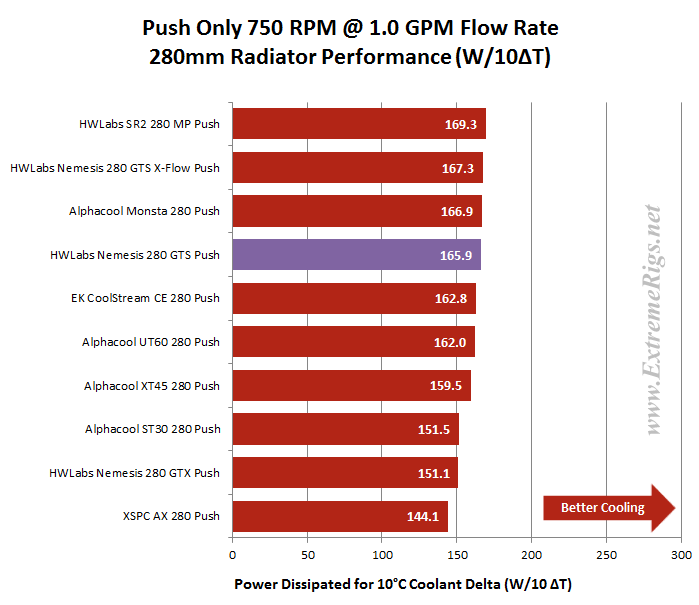
Clearly this results is fantastic for the Nemesis 280 GTS. Finishing in fourth place and just 2% behind the winner. Of more interest is that all but one (which is the same thickness) of the radiators below it are at least 25% thicker, some are in fact twice as thick!
Now let’s look at 1300 rpm:
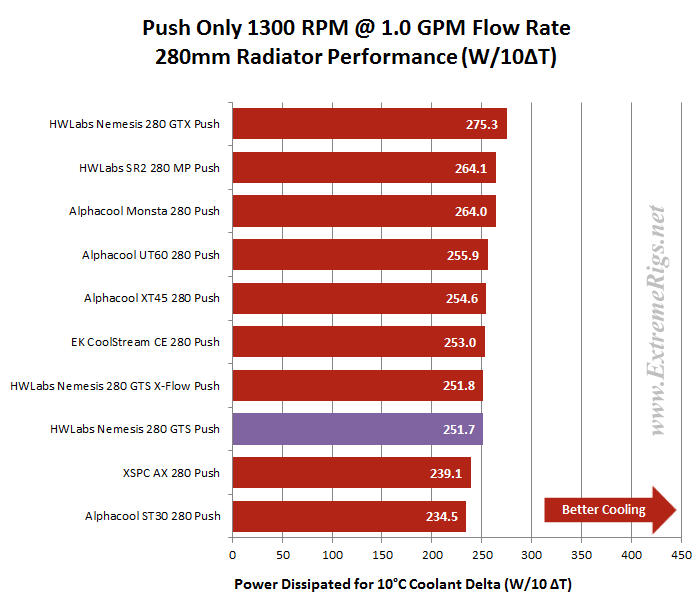 At Push Only 1300 RPM the group settles roughly into order of thickness. The 2 Nemesis GTS models have virtually identical results and are ~7% ahead of the other slim in the group.
At Push Only 1300 RPM the group settles roughly into order of thickness. The 2 Nemesis GTS models have virtually identical results and are ~7% ahead of the other slim in the group.
Now 1850 rpm Push Only:
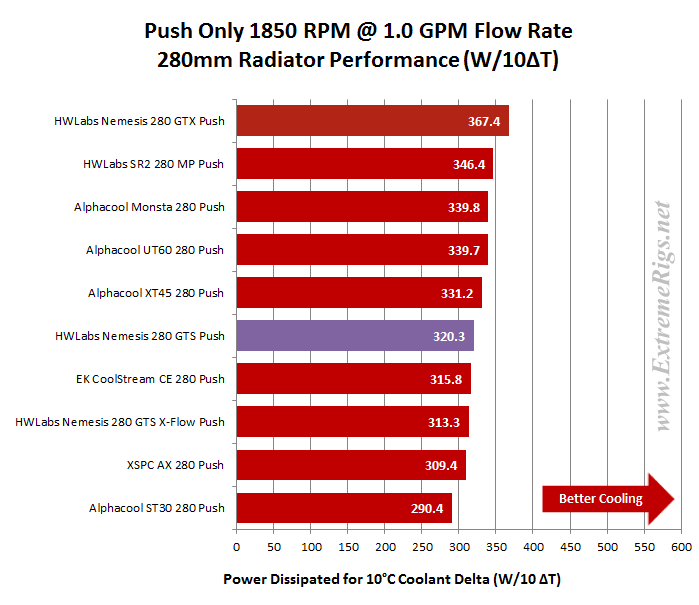 At 1850 rpm the Nemesis 280 GTS climbs a few spots and finishes 13% behind it’s dominant stable mate, the Nemesis GTX which is 25mm (or + 83%) thicker. Of more relevance though is that it is the best performing slim radiator and is even ahead of thicker radiators such as the CE and AX.
At 1850 rpm the Nemesis 280 GTS climbs a few spots and finishes 13% behind it’s dominant stable mate, the Nemesis GTX which is 25mm (or + 83%) thicker. Of more relevance though is that it is the best performing slim radiator and is even ahead of thicker radiators such as the CE and AX.
Let’s find out how the Nemesis 280 GTS performs with Push/Pull fans.
Push/Pull Data vs. Competition
Firstly the 750 rpm:
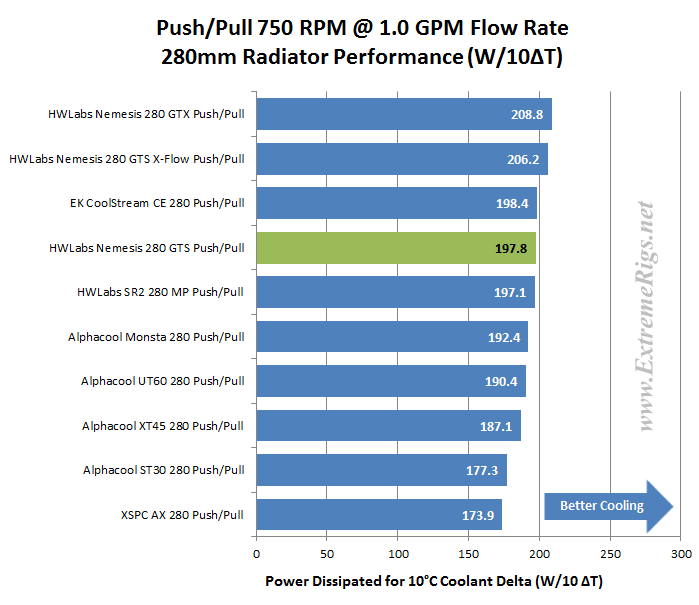 Again the Nemesis 280 GTS is at the top end of the comparison chart in the low speed fan results.
Again the Nemesis 280 GTS is at the top end of the comparison chart in the low speed fan results.
Let’s move to 1300 rpm:
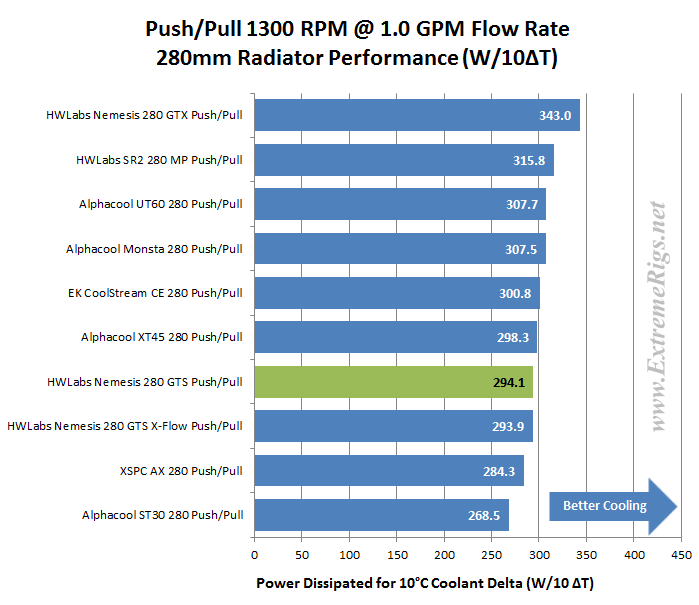 Here we see very similar ranking to which we saw at Push Only 1300. In Push/Pull the Nemesis 280 GTS and it’s sibling X-Flow variant have again performed almost identically and are clear of the other slim radiator by ~9%.
Here we see very similar ranking to which we saw at Push Only 1300. In Push/Pull the Nemesis 280 GTS and it’s sibling X-Flow variant have again performed almost identically and are clear of the other slim radiator by ~9%.
Now 1850 rpm:
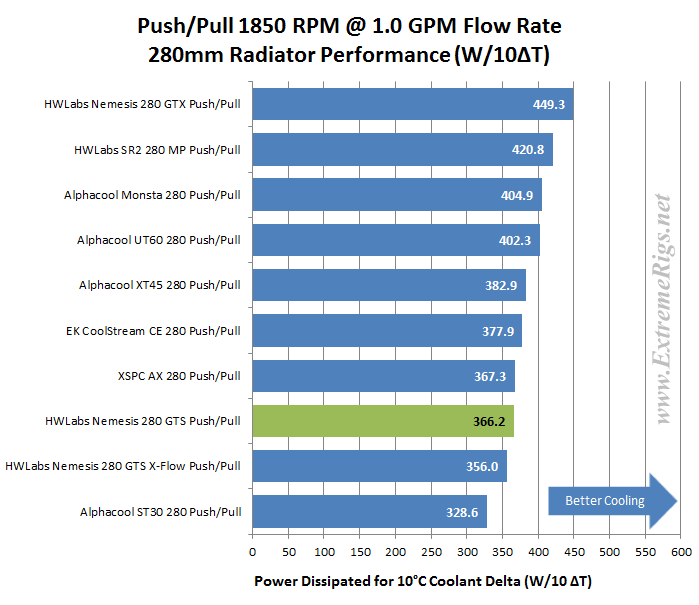 At 1850 rpm Push/Pull the Nemesis 280 GTS is the clear winner of the slims in the group. It can’t match the performance of the thicker radiators but is not too behind the 45mm thick models.
At 1850 rpm Push/Pull the Nemesis 280 GTS is the clear winner of the slims in the group. It can’t match the performance of the thicker radiators but is not too behind the 45mm thick models.
Let’s now combine the Push Only and Push/Pull results of our 1.0 GPM flow rate tests. Sometimes these combined plots show up points of interest, though they can get a little busy and perhaps confusing if you’re not used to them.
It turns out that only the 1850 RPM has something of interest so the 750 rpm and 1300 rpm plots are spoilered.
At 1850 the Push Only result of the Nemesis 280 GTS is only 2.5% behind the Push/Pull result of the ST30 which is also a 30mm thick radiator. Nice!!
On the other side of the coin the Nemesis 280 GTS’ Push/Pull (80mm total thickness) result is worse than the Nemesis GTX’s Pull Only result which is 79mm thick.
Another view of the same data, this time plotted as curves and some extrapolation added.
Be warned these plots can be hard to read given that many results are similar at the same data points.
Again the Push Only data first:
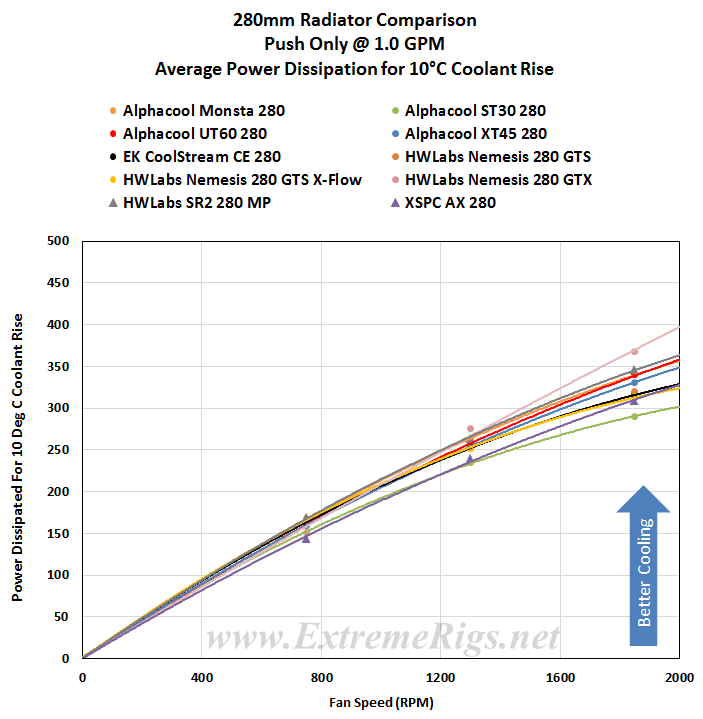 This perhaps best shows just how close the results are, particularly with low speed fans.
This perhaps best shows just how close the results are, particularly with low speed fans.
Because the data curves in plot above are almost blurred into one another, we have split it into two separate plots; 750 rpm to 1300 rpm and 1300 rpm to 1850rpm and zoomed in on those fan speed zones.
Now the Push/Pull results are plotted, again followed by split and zoomed versions.
Nemesis 280 GTS vs. Nemesis 360 GTS
Before moving on let’s take a quick look at the thermal results for the Nemesis 280 GTS and Nemesis 360 GTS on the same plot. This is one of those “just for fun” plots because in reality we can’t make a 1 to 1 comparison between the two sizes because of the differing performance of the fans used.
The Nemesis 280 GTS has ~10% less surface area than the Nemesis 360 GTS. Knowing that and the difference in fans used to test the 120.x and 140.x radiators, interpret the following as you will.
Push Only 750 rpm: Nemesis 360 GTS was ~11.5% better.
Push/Pull 750 rpm: Nemesis 360 GTS was ~3.5% better.
Push Only 1300 rpm: Nemesis 360 GTS was ~13.5% better.
Push/Pull 1300 rpm: Nemesis 360 GTS was ~5.5% better.
Push Only 1850 rpm: Nemesis 360 GTS was ~13.5% better.
Push/Pull 1850 rpm: Nemesis 360 GTS was ~3.5% better.
Which is an overall average of ~8.5% better performance in favor of the Nemesis 360 GTS, which has a ~10% greater surface area.
BUT, what I find most interesting is that the Nemesis 360 GTS’ Push Only results were almost equal to the Nemesis 280 GTS’ Push/Pull results.
From every radiator tested we create APF “Average Performance Factor” charts from both the Push Only and Push/Pull results. We also make a combined plot of the average called the “Master Performance Factor”. The radiator with the best cooling ability (W/10ΔT) at each rpm is awarded a score of 100 and every other radiators W/10ΔT result is scored as percentage of the top performer.
This way of looking at the comparison takes away any advantages that a radiator may have at higher or lower fan speeds and looks at an overall average. While this appears fair it does tend to favor those radiators that are all-rounders and those radiators which do very well at high RPM. Most users should be more focused on their specific use case.
Here are the Nemesis 280 GTS’ percentage scores at each data point:
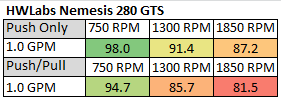 This table shows us that the Nemesis 280 GTS is on average ~10% behind the best performing radiator at each data point that was tested, but range from 2% to over 22%. The results “appear” to get worse with increased fan speeds, but that does not mean that the Nemesis 280 GTS’ performance got worse, more so that the best radiator got better as the fan speeds increased.
This table shows us that the Nemesis 280 GTS is on average ~10% behind the best performing radiator at each data point that was tested, but range from 2% to over 22%. The results “appear” to get worse with increased fan speeds, but that does not mean that the Nemesis 280 GTS’ performance got worse, more so that the best radiator got better as the fan speeds increased.
As these percentage scores are relative to the best performer at each data point, we again advise readers to cross reference specifications and results for each radiator and keep in mind your intended fan assembly and operating speed.
The percentage numbers in the table above offer another way of looking at the Nemesis 280 GTS’ results. But for our scoring system we need a way to reduce the categories while retaining the data. To do this we average the results for each fan assembly type giving us Averaged Performance Factors. We calculate this for Push Only, Push/Pull and finally an average of everything.
Firstly – the Push Only APF:
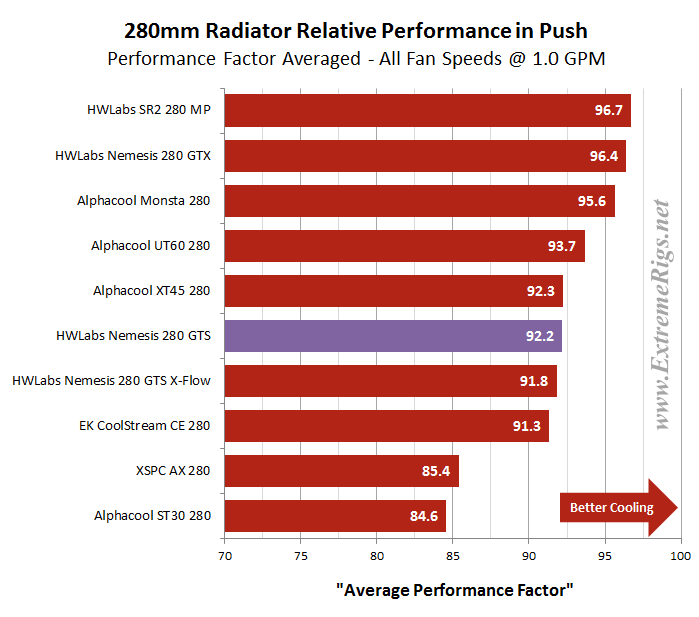 With an 92.2 % Averaged Push Only result the Nemesis 280 GTS places equal 5th (after test error margin is factored in) with a radiator which is + 50% thicker than it. This is an excellent data set for the Nemesis 280 GTS.
With an 92.2 % Averaged Push Only result the Nemesis 280 GTS places equal 5th (after test error margin is factored in) with a radiator which is + 50% thicker than it. This is an excellent data set for the Nemesis 280 GTS.
Now the Push/Pull APF:
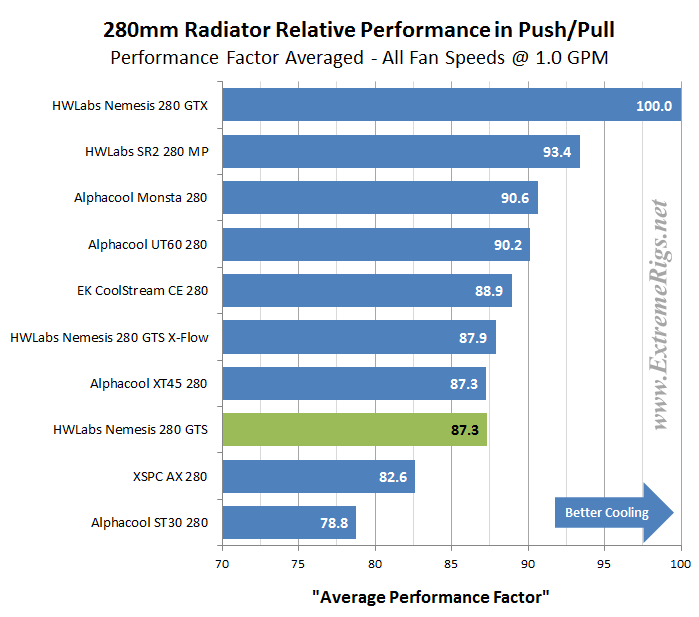 In Push/Pull APF rankings the Nemesis 280 GTS places equal 6th with it’s sibling X-Flow variant and a 45mm thick radiator. Any weak points were somewhat magnified by the 100% score on the Nemesis 280 GTX. All in all the Nemesis 280 GTS performed very well here given it’s thickness and was in equal 1st place for the slim radiators of the group.
In Push/Pull APF rankings the Nemesis 280 GTS places equal 6th with it’s sibling X-Flow variant and a 45mm thick radiator. Any weak points were somewhat magnified by the 100% score on the Nemesis 280 GTX. All in all the Nemesis 280 GTS performed very well here given it’s thickness and was in equal 1st place for the slim radiators of the group.
Finally we created the Master Performance Factor which is calculated from the averaged results of all the Push Only and Push/Pull thermal tests, at all fan speeds.
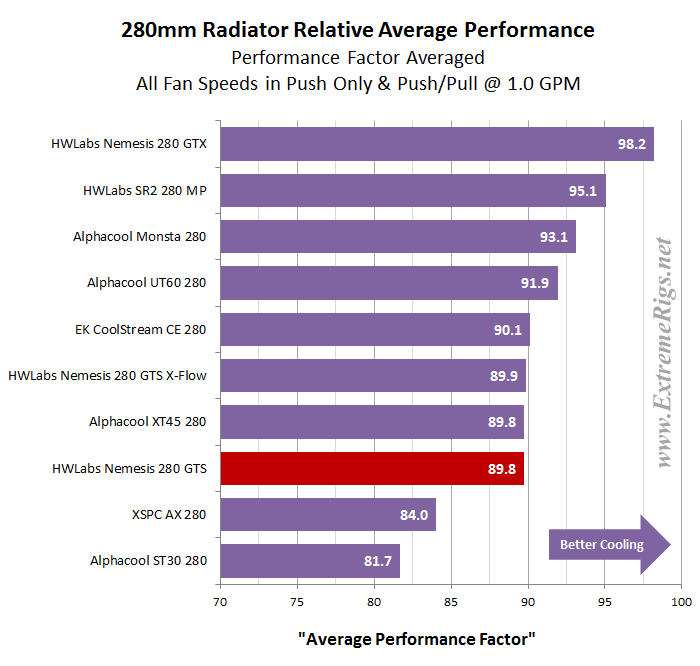 The Nemesis 280 GTS placed equal 6th overall, ~ 8.5% behind the winning radiator. Of more relevance is that it came in as equal top performing slim radiator.
The Nemesis 280 GTS placed equal 6th overall, ~ 8.5% behind the winning radiator. Of more relevance is that it came in as equal top performing slim radiator.
Space Efficiency
The Nemesis 280 GTS’ space efficiency vs. performance ranking is likely to be very good as thinner radiators almost always produce better results here than their thicker counterparts. We have used the Average Performance Factor results from the charts above to compile two plots which shows us how it compares to the other rads in terms of performance Vs. space taken.
First up is Radiator Thickness Vs. APF
Here the combined APF scores were divided by the radiator thickness only, with the highest (most space efficient) issued a score of 100. Each of the other radiators results was converted to a percentage of the most space efficient radiator’s score.
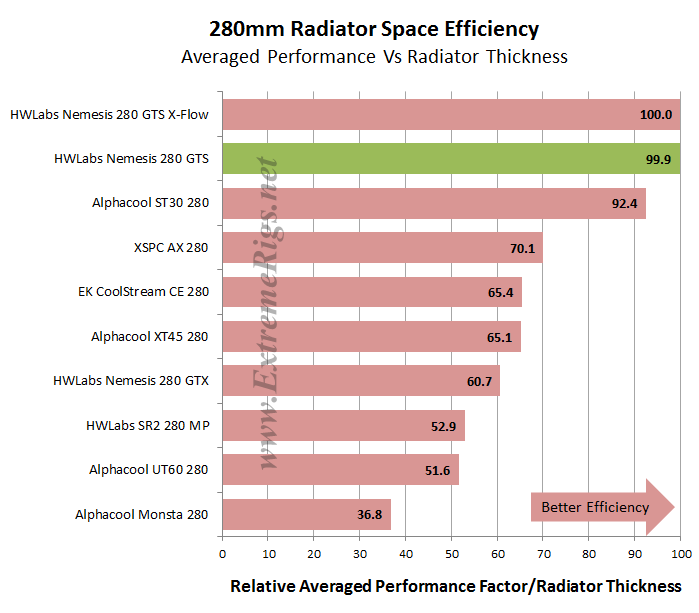 Lets call this an equal 1st place. The order has ended almost in order of thinnest to thickest and as anticipated the Nemesis 280 GTS ranked highly in this comparison.
Lets call this an equal 1st place. The order has ended almost in order of thinnest to thickest and as anticipated the Nemesis 280 GTS ranked highly in this comparison.
Next we took the APF results for Push/Pull and divided it by the total thickness including the fans and applied the same scoring system. For the Push Only we used the Push Only Vs Push/Pull comparative results and applied the same scoring system when compared against the Push/Pull.
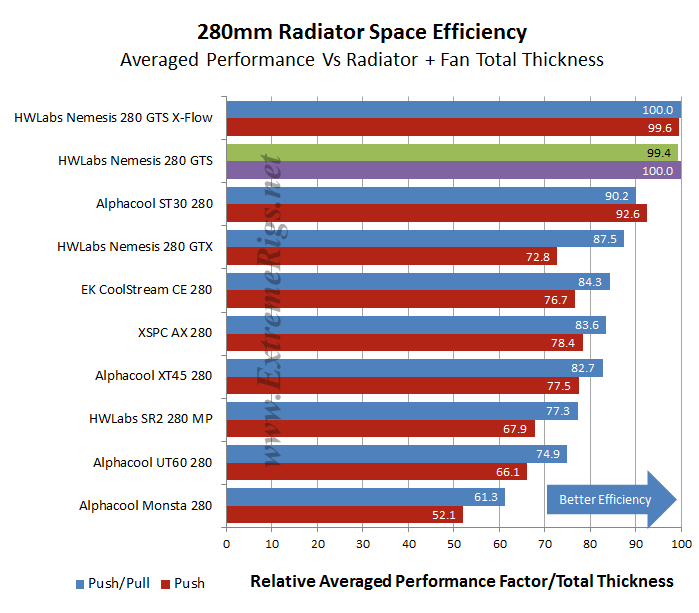 This plot is likely the most useful of the 2 plots for readers looking at space efficiency. With fan thickness factored in the Nemesis 280 GTS finishes in equal 1st place for both Push Only and Push/Pull.
This plot is likely the most useful of the 2 plots for readers looking at space efficiency. With fan thickness factored in the Nemesis 280 GTS finishes in equal 1st place for both Push Only and Push/Pull.
Value Factor
While our APF’s are still fresh in mind, let’s now look at some results vs Price to show which of the 280mm radiators might offer the best bang for your buck. Each radiator’s combined APF scores were divided by the radiator cost and again we applied our scoring system of percentage Vs. the best performer of the category.
The Nemesis 280 GTS’ Value Factor turns out to be the best of the group, which tells us that it offers excellent value for the performance potential it offers. In reality the difference is not great, but when visualizing with percentages as we have done, the gap appears large. Generally value and space efficiency metrics usually correlate – thicker radiators do contain more material afterall and so are usually also more expensive.
Next Up – Summary!








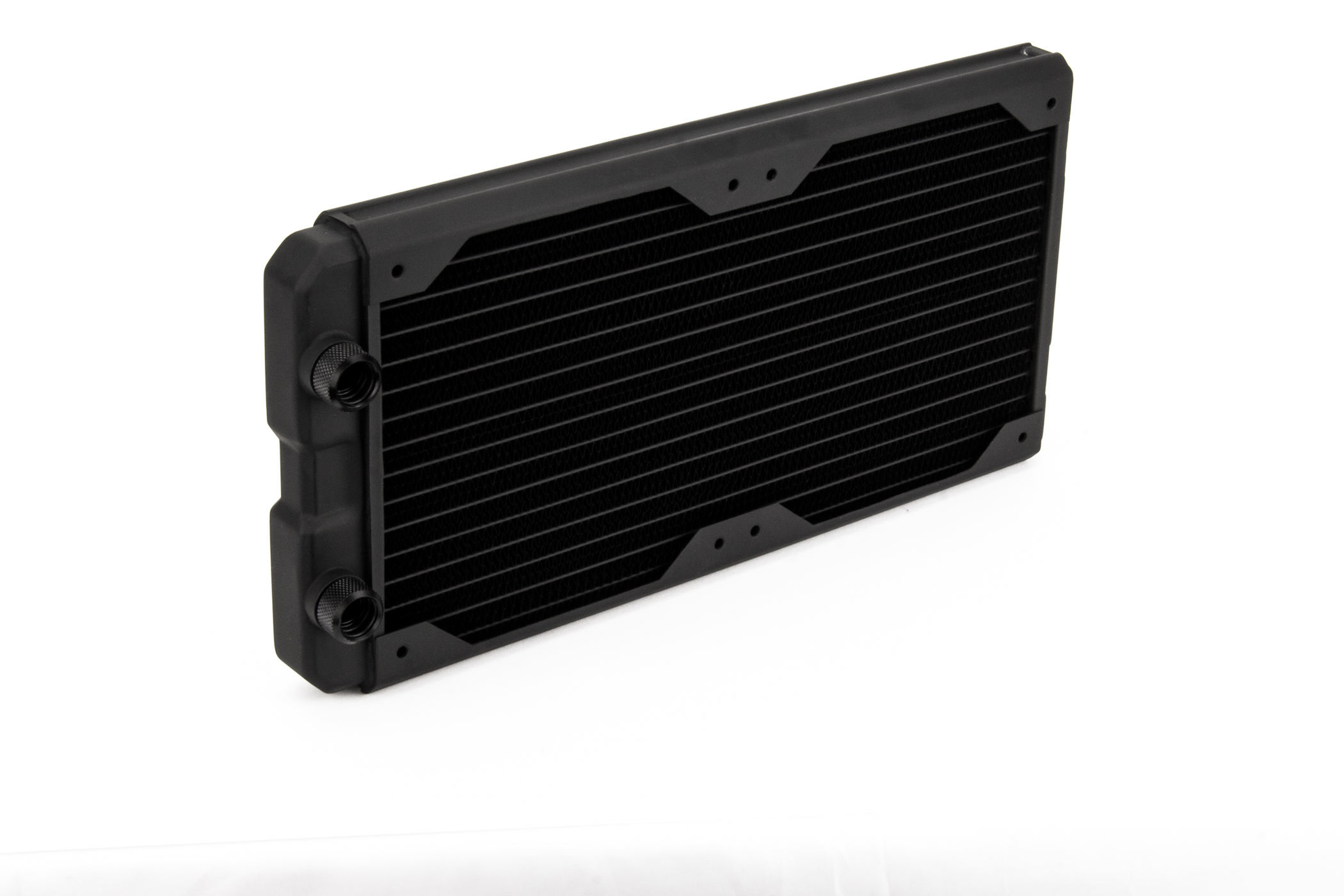
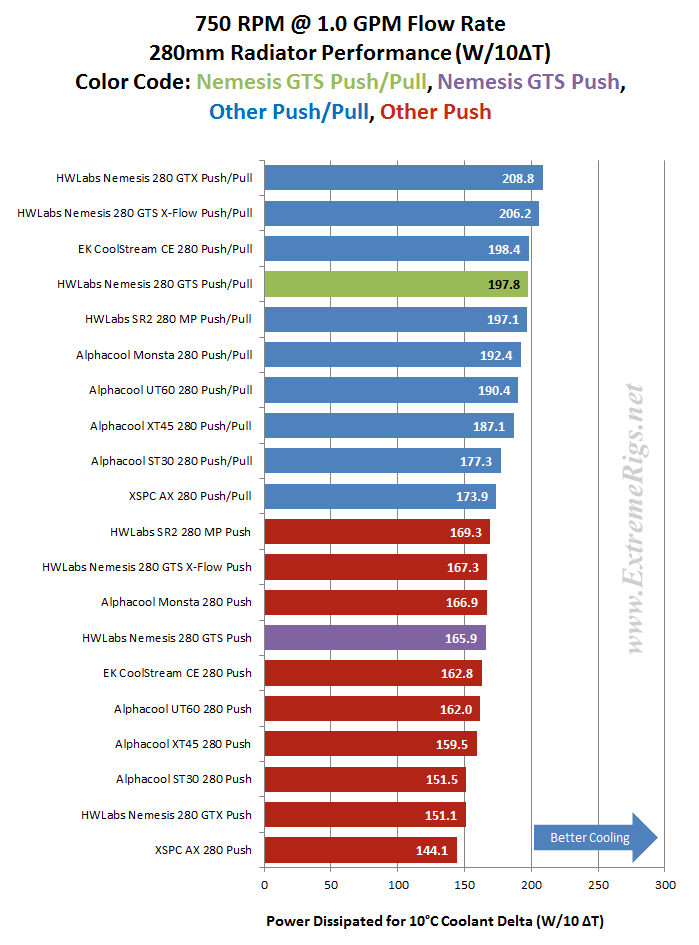
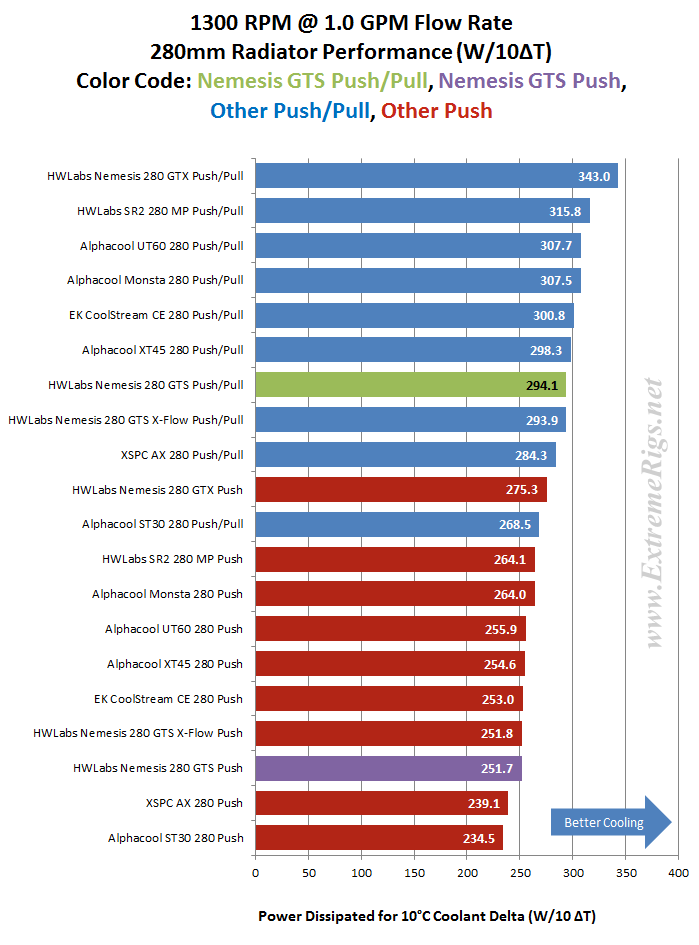
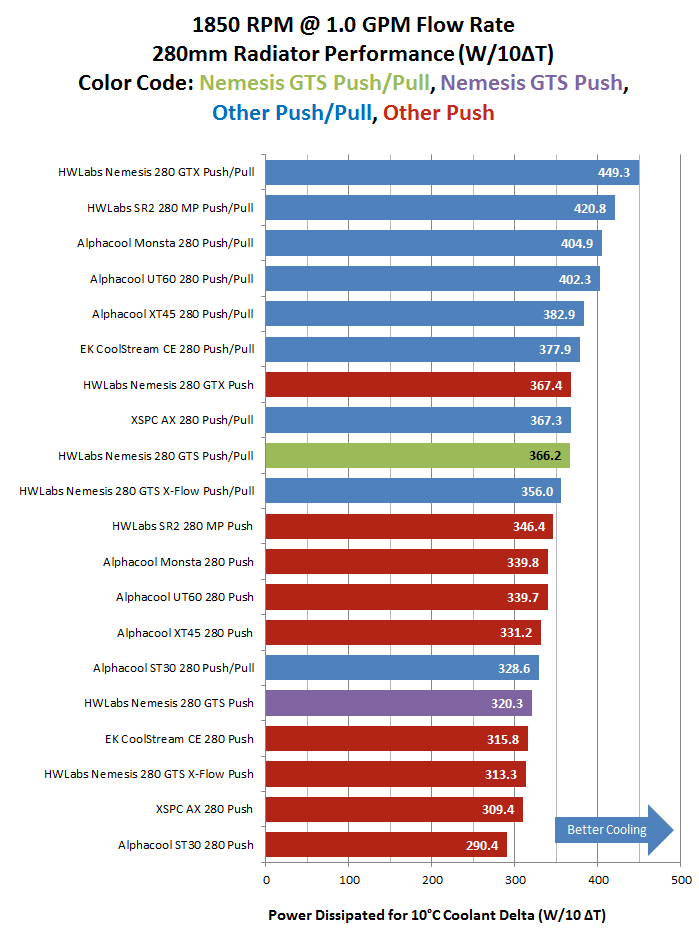
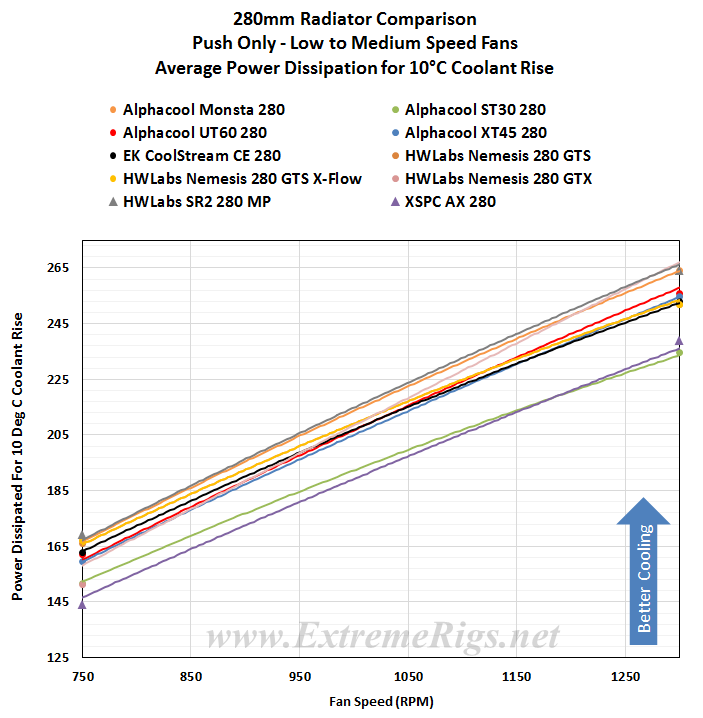
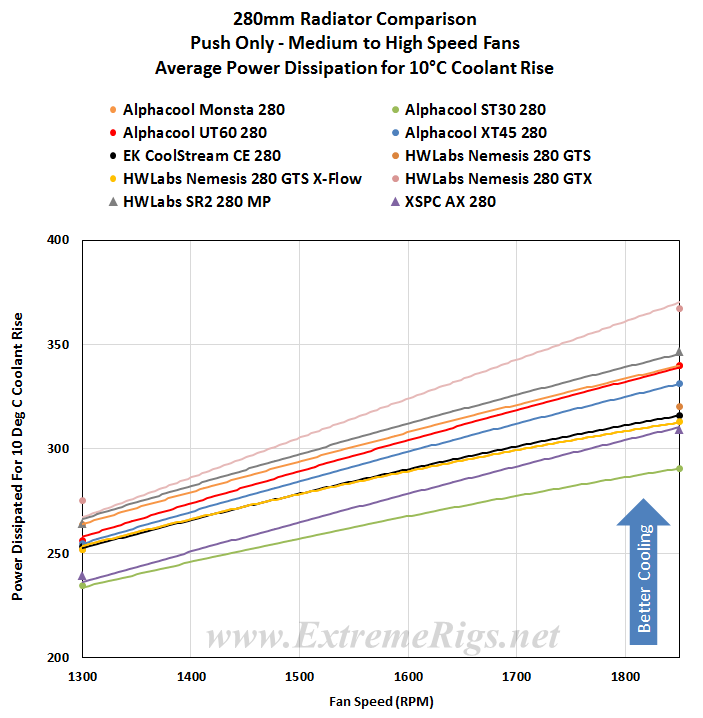
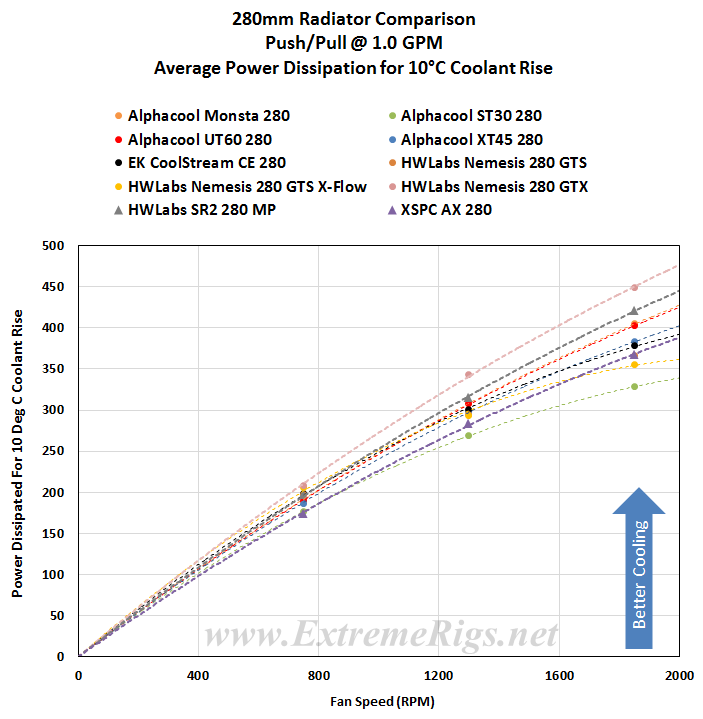
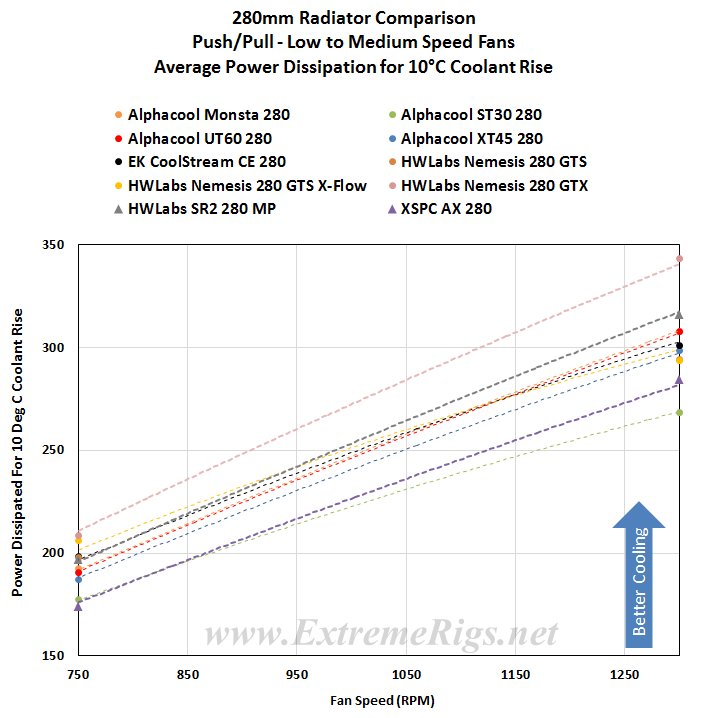
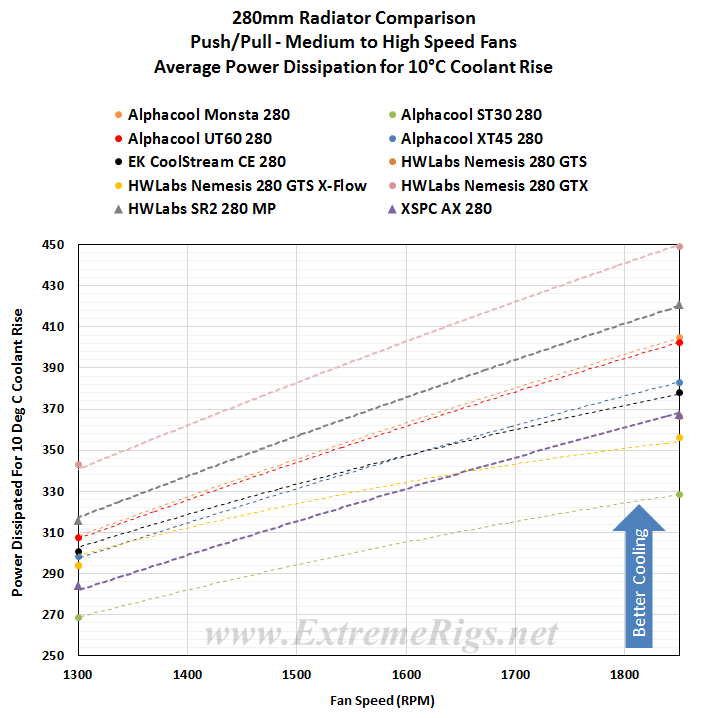
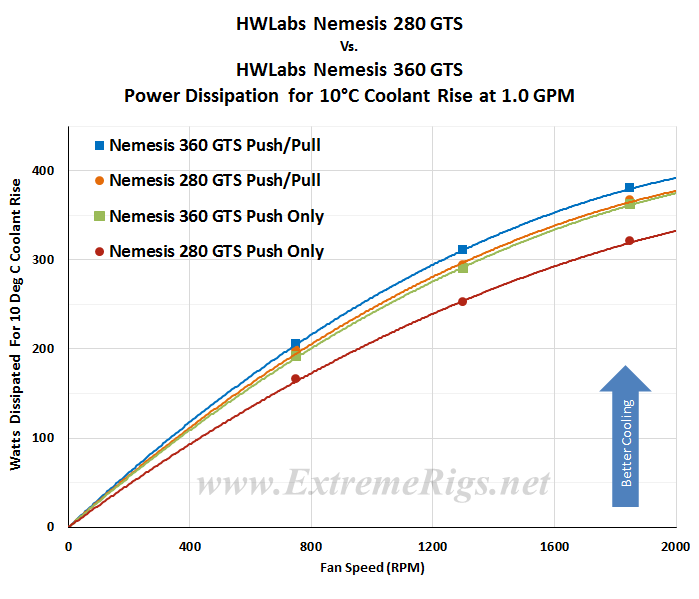
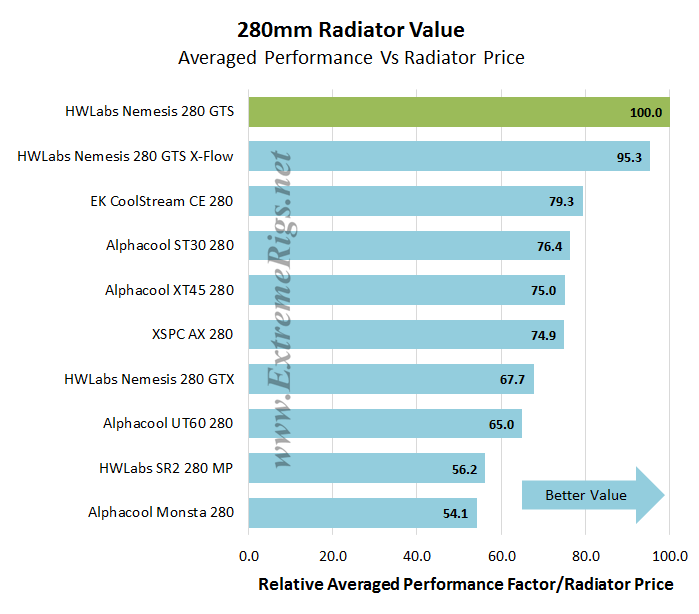



Another great radiator review! I love the exact TDP dissipation numbers at different fan speeds.
The GTS series looks like the radiator to beat in the thin category. I especially like the fact that these are non-louvered designs which seem to require less static pressure than louvered, and obviously “store” less dust. I have both the white GTS and GTX radiators in 280mm, as well as an L-Series which is a bit easier to fit because it has the reduced width. All have been great even at low fan speeds. I have a crossflow 280GTS and a 280GTS L-series in a modified Corsair 350D with hih airflow front panel, with push only Thermaltake Riing fans (140mm) and they cool my i7 5960x at 4Ghz and my 980Ti at 1.55ghz (I got lucky) amazingly at 1000 RPM. Highest temps on the i7 5960x at 1.20 volts are 65 celsius (except with Prime 95 AVX which goes to 75) and the 980Ti is only at 43 celsius at full bore, and my water temps are only around 6-8 celsius Delta-T. Amazingly quiet and cool. I could theoretically add another 980Ti to the loop with only a slight increase in fan speeds and not have to worry about over-subscribing the water cooling loop, based on the heat dissipation potential shown here.
Comments are closed.